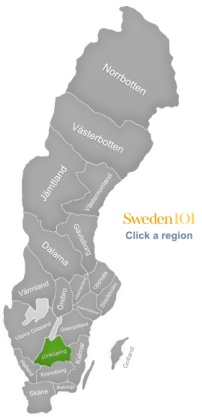Jönköping - Jönköping city, Vättern, Visingsö

What does the name of the region mean?
Jönköping is name after the city of Jönköping, whose name consists of two different parts: Jön refers to a creek in the region, and the word köping is used to describe a center of trade. So Jönköping basically means that it is a center of trade next to a stream – and this is a very fitting description.
What is the region's historical importance?
Unfortunately, the location of the region made it quite vulnerable to attacks from the Danes, who – in the past – were ruling the Southern parts of what is now Sweden. They often came to the Jönköping via the rivers and plundered the town of Jönköping.
What is the region known for?
One of the things Jönköping is known for is the world's largest forestry fair with the name of Elmia wood. In addition to that, Elmia is also home to the world's largest LAN party (happens twice a year: DreamHack Summer and DreamHack Winter). The region is rather industrial today, with many big companies like Husqvarna, Ikea, and Electrolux having big warehouses and distribution centers in the region. There are many different fairs and exhibitions throughout the year.
Until 1970, the region was also known for its very successful matchstick industry – but as you can imagine, matchsticks don't play that much of role these days.
What are some places you need to visit in Jönköping?
Jönköping city
Jönköping used to be an important center of trade, as it was on the crossroad to other locations, and also nestled between two other Swedish regions. Many traders had to travel through this place to get to their final destination. The city is often also called “The Jerusalem of Sweden” because there are is a relatively high number of churches in the city. Apart from churches (many of them are open to the public, but be respectful if there is a service in progress), the city of Jönköping is very interesting and has a lot to offer. There is a park which has hundreds of different of varieties of roses, a fantastic beach at Sweden's second largest lake (see next point), a great swimming hall, and a good number of interesting museums in which you can learn more about history, heritage, art, and matches even!
Vättern
Vättern is the second largest lake in Sweden, and can be easily accessed from the city of Jönköping. It also is the fifth largest lake in all of Europe. The lake has crystal clear water, and because the water is so clean, most of the towns and villages get their drinking water straight from the lake (but for safety reasons the water is still processed before it goes to the households). If you are thirsty and next to this lake, then you can safely drink this water as no sewage at all is pumped into this lake, and the Swedish people are quite proud about the cleanliness around this lake. People are allowed to fish in the lake, but not with nets.
Visingsö
A visit to the island of Visingsö makes for a fantastic day trip. You can go on a tour of the island in a horse buggy or also just explore the island on your own. There are some old castle ruins and a lovely herb garden that you can visit. The island is in the lake, so it is not such a huge place – legend says that the island only exists because a giant's wife did not want to go to the other side of the lake because she did not want to get her feet wet. So the giant threw a giant rock into the lake. His wife could then use that rock as a stepping stone, and while the giants are both gone now, the “stepping stone” is still there, and enjoyed by many visitors.

_(2).jpg)